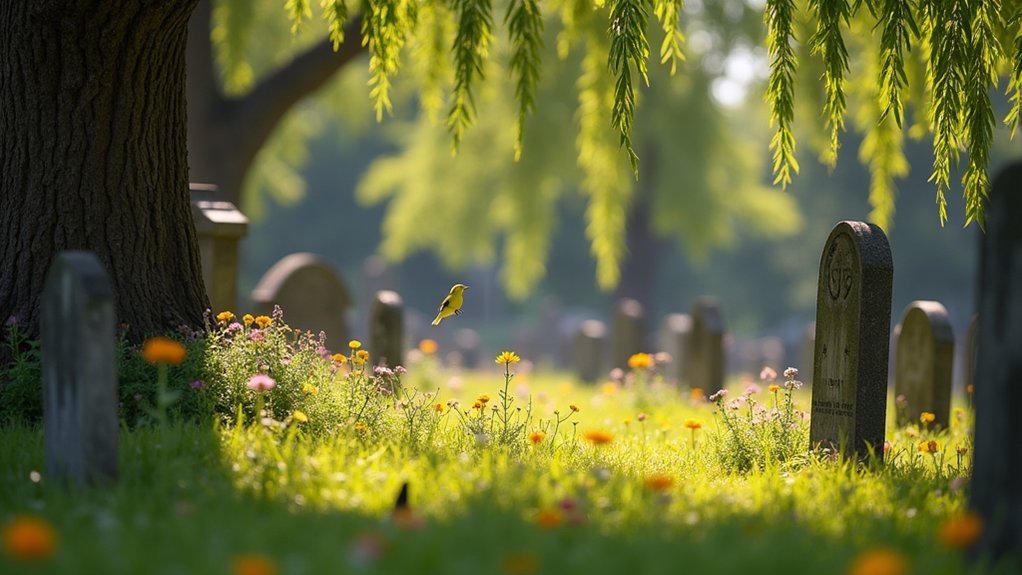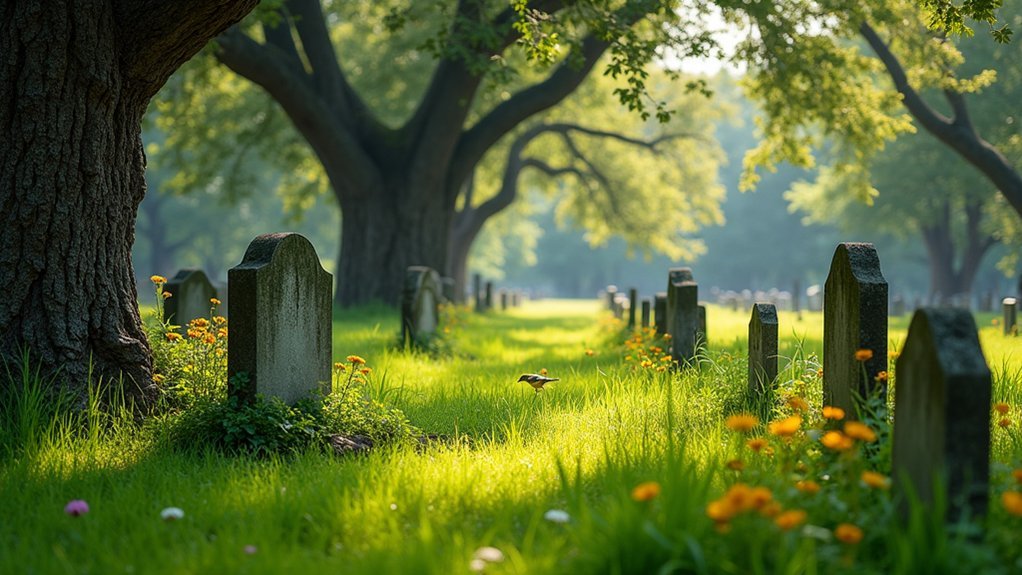Cemeteries provide ideal warbler migration stopovers due to their mature trees, diverse vegetation, and undisturbed environments. You’ll find these urban sanctuaries offer vertical diversity with different feeding zones, abundant insects, and shelter from predators. The stone monuments create protective microclimates by blocking wind and retaining heat, helping tired birds conserve energy. Cemetery management practices like native plantings and water features further enhance these habitats. Discover how these peaceful islands support countless birds on their remarkable journeys.
The Ecological Significance of Cemetery Landscapes for Migrating Warblers

While many overlook cemeteries as merely places for memorializing the dead, these green sanctuaries serve as crucial refueling stations for warblers during their exhausting migratory journeys.
You’ll find these stopover sites particularly valuable because of their diverse habitats featuring mature trees and native vegetation that provide food and shelter for numerous warbler species.
Water features within cemeteries offer critical hydration sources, attracting migrating birds that need to replenish their energy reserves.
What makes these landscapes especially beneficial is their well-maintained nature, supporting nutrient-rich vegetation that boosts insect populations—a crucial high-energy food source for insectivorous warblers.
Prestigious urban cemeteries like Mount Auburn and Green-Wood have become recognized biodiversity hotspots, drawing not only Cerulean Warblers and other migratory songbirds but also contributing to conservation efforts and birding tourism.
Mature Trees and Diverse Vegetation: A Warbler’s Sanctuary
When you walk through a cemetery during warbler migration season, you’re actually entering a multi-layered habitat where mature trees create vertical diversity essential for different warbler species.
Ancient oaks in these protected spaces offer not just aesthetic value but critical shelter for exhausted migrants needing safe rest stops during their arduous journeys.
The undisturbed canopy networks formed by decades-old trees provide interconnected pathways that allow warblers to move safely above ground while foraging for insects hidden among the leaves.
Vertical Habitat Diversity
Towering oaks and maples in cemeteries create vertical ecosystems critical for migrating warblers. These mature trees form an ideal stratification that provides multiple feeding zones where different warbler species can find their preferred prey.
As important stopover sites, cemeteries offer everything from canopy heights to mid-story branches to understory shrubs.
You’ll notice migrating songbirds distributing themselves throughout this vertical space based on their specialized habitat use patterns. Blackburnian Warblers might search high in the treetops while Common Yellowthroats forage closer to the ground.
This layered structure isn’t just convenient—it’s essential for efficient refueling during migration journeys. The trees also create windbreaks and shelter from predators, allowing warblers to conserve energy while safely replenishing their fat reserves before continuing their remarkable journeys.
Ancient Oaks Provide Shelter
The ancient oaks that dominate cemetery landscapes represent irreplaceable sanctuaries for migrating warblers.
You’ll find these magnificent trees serving as critical safe havens amid otherwise developed urban environments. Their sprawling branches and dense foliage create protected nesting spaces where warblers can rest during their exhausting migration journeys.
These mature trees also function as strategic perches, allowing warblers to survey surroundings for both food and threats.
The oaks support rich insect populations in their bark and leaves, providing immediate sustenance for hungry travelers. When combined with diverse understory vegetation and occasional water features, these ancient sentinels create complete ecosystems within cemetery grounds.
For warblers traversing between summer breeding grounds and winter territories, these island-like shelters amid urban landscapes can mean the difference between successful migration and perilous passage.
Undisturbed Canopy Networks
Beyond individual ancient oaks, entire cemetery canopy networks create exceptional warbler havens during migration.
As you walk through these peaceful grounds, you’ll notice how mature trees form interconnected green corridors that migratory birds depend on for navigation and rest.
These undisturbed canopies offer consistent shelter where warblers can safely refuel before continuing their journey.
Cemetery vegetation typically includes diverse native plants that attract insects—a vital food source during spring migration.
You’ll find that the minimal human activity in these spaces allows warblers to feed and rest without the constant disruptions found elsewhere in urban environments.
The varied habitat diversity within cemetery grounds, from dense tree cover to open areas with water features, creates ideal stopover sites that support multiple warbler species with different ecological needs throughout their migration seasons.
Comparing Cemetery Stopovers to Natural Habitats
You’ll find cemeteries serve as habitat islands where warblers can rest undisturbed, unlike many fragmented natural areas in urban settings.
Their multi-layered vegetation structure—from mature canopy to flowering understory—mimics the complexity of forests that warblers depend on during migration.
With fewer joggers, dogs, and loud activities than public parks, these sacred spaces offer migrating warblers the reduced disturbance they need to safely refuel before continuing their journey.
Undisturbed Habitat Islands
While natural forests and wetlands remain ideal warbler habitats, urban cemeteries have emerged as surprisingly effective migration stopovers that rival their natural counterparts in several key aspects.
As cities expand outward, cemeteries function as undisturbed habitat islands amid concrete landscapes. You’ll find these peaceful enclaves offer migratory birds essential resources that disappearing natural spaces once provided.
Unlike many urban parks with constant human activity, cemeteries provide quiet periods where warblers can feed and rest without significant disturbance.
The ecological value of these stopover sites often matches or exceeds fragmented natural areas. Their consistent maintenance guarantees reliable food sources and shelter year after year—something increasingly rare as development transforms once-pristine landscapes.
For warblers traversing urbanized corridors, these sanctuary-like spaces have become critical stepping stones along increasingly challenging migratory routes.
Diverse Vegetation Structure
The multi-layered vegetation found in cemeteries creates habitat complexity that closely resembles natural forest environments preferred by migrating warblers.
You’ll notice these urban sanctuaries offer exceptional stopover sites with their combination of mature trees, flowering shrubs, and native plants—all attracting the insects warblers depend on during migration.
Unlike manicured parks, cemeteries provide:
- Varied canopy heights that mimic forest stratification
- Nutrient-rich native plantings that support insect populations
- Water features that supplement food and hydration sources
When you explore these peaceful grounds during migration season, you’ll find Cerulean Warblers and other species utilizing the diverse vegetation structure just as they’d in natural habitats.
The well-maintained paths make these biodiversity hotspots particularly accessible for observing these colorful migrants as they refuel.
Reduced Urban Disturbance
Beyond their vegetation diversity, cemeteries offer migrating warblers another significant advantage: reduced urban disturbance.
While bustling city parks and green spaces experience constant human activity, cemeteries maintain a quieter, more peaceful environment that’s ideal for these sensitive migratory birds.
You’ll notice warblers can feed and rest with minimal stress in these tranquil settings. The lower noise levels and reduced foot traffic create premium stopover sites where birds can efficiently refuel during their exhausting journey.
This relative calm stands in stark contrast to other urban habitats where birds must constantly remain vigilant.
The combination of established visiting hours, respectful visitor behavior, and cultural norms of cemetery quietude creates micro-sanctuaries within urban landscapes.
This balance of accessibility and protection makes cemeteries uniquely valuable refuges for warblers traversing through developed areas.
Seasonal Patterns of Warbler Migration Through Historic Burial Grounds
During peak migration seasons, historic burial grounds transform into vibrant sanctuaries for passing warblers, creating a remarkable juxtaposition of life within these peaceful memorial spaces.
You’ll notice these migratory birds utilizing cemetery trees and shrubs as critical stopover sites during both spring migration and fall journeys.
- Mount Auburn Cemetery has become legendary among birders who document Cerulean Warblers and other species feeding on insects near water features.
- Peak warbler activity typically occurs in May and September when these birds need nutrient-rich environments to refuel.
- Birding clubs organize regular cemetery walks timed precisely to migration patterns, offering you opportunities to witness this natural phenomenon.
The predictable seasonal patterns make cemeteries reliable hotspots for observing warblers as they navigate through urban landscapes on their long-distance migrations.
Food Resources and Foraging Opportunities in Cemetery Ecosystems

Mature trees and diverse native plantings within cemetery landscapes create ideal foraging ecosystems where migrating warblers can replenish their energy reserves.
You’ll find these green spaces teeming with insects and seeds that provide essential nutrition for hungry migratory species like the Cerulean Warbler.
Water features throughout these sanctuaries support invertebrate populations, expanding food resources beyond what you’d expect in urban environments.
Well-maintained flowering plants offer additional nectar sources, attracting various insects that warblers enthusiastically consume during their stopover.
The strategic position of cemeteries within urban settings creates unique foraging opportunities that complement surrounding landscapes.
This habitat diversity guarantees warblers can find sufficient nourishment regardless of their dietary preferences, making cemeteries vital refueling stations along challenging migration routes.
Urban Cemetery Islands: Refuge in a Sea of Development
While concrete and asphalt dominate urban landscapes, historic cemeteries stand as verdant sanctuaries where migrating warblers find essential respite.
These green islands serve as critical stopover sites during the migration period, offering what many species desperately need—a place to rest and refuel.
You’ll discover that these pockets of nature provide:
- Diverse habitats with mature trees and shrubs that attract insects for hungry warblers
- Protected spaces free from the noise and dangers of surrounding development
- Accessible green corridors that connect otherwise fragmented habitats
The ecological value of these cemetery sanctuaries can’t be overstated.
They function as biodiversity hotspots in otherwise inhospitable urban environments, allowing various warbler species to successfully complete their arduous migratory journeys despite increasing urbanization challenges.
Weather Protection and Microclimate Benefits of Monument-Rich Environments

When you walk through a cemetery during migration season, you’re actually entering a complex refuge where stone monuments serve as essential windbreaks for exhausted warblers.
These grave markers absorb solar energy during daylight hours and gradually release heat throughout the night, creating warm pockets that can mean survival for birds battling cold spring or fall temperatures.
You’ll notice warblers concentrating around the larger monuments and mausoleums, where the combination of wind protection and thermal benefits creates microhabitats that can be several degrees warmer than surrounding open areas.
Monument Windbreaks Effect
Beyond their memorial purpose, cemetery monuments create protective microclimates that serve migrating warblers remarkably well. As you explore these unique stopover sites, you’ll notice how the strategic arrangement of headstones and sculptures forms effective monument windbreaks, reducing wind speeds considerably. This energy-saving benefit directly impacts warblers’ refueling rates during critical migration periods.
The monuments’ windbreak effect provides several advantages:
- Creates sheltered pockets where birds can forage while expending less energy
- Helps maintain higher ambient temperatures, encouraging insect activity that supplies crucial food
- Forms protected resting areas where warblers can recover without battling harsh elements
This microclimate effect, combined with minimal human disturbance, makes cemeteries ideal sanctuaries for these tiny travelers. The stone structures fundamentally function as natural shields, transforming open spaces into hospitable habitats during challenging migratory journeys.
Thermal Heat Retention
The monuments that shield warblers from wind also function as remarkable thermal repositories during migration seasons. These stone structures absorb solar radiation during the day and slowly release heat throughout the night, creating pockets of warmth that help warblers conserve energy when temperatures drop.
You’ll notice that this thermal heat retention is essential for migrating species. At these stopover sites, warblers need to maintain their body temperature efficiently to support fat accumulation—important fuel for their long journeys.
The cemetery’s unique combination of monuments, mature trees, and water features creates a microclimate that’s often several degrees warmer than surrounding areas. This temperature advantage can make the difference between a successful migration and depletion of critical energy reserves, especially during unpredictable weather patterns in spring and fall migration periods.
Historic Cemetery Management Practices That Benefit Migrating Birds
Since the early 19th century, cemetery management practices have undergone a remarkable transformation that has inadvertently created ideal habitats for migrating warblers.
Mount Auburn Cemetery, established in 1831, pioneered the rural cemetery movement, emphasizing aesthetic landscapes that now serve as vital migratory stopover sites.
You’ll find these historic management practices benefit warblers through:
- Implementation of diverse native plantings that provide nutrient-rich food sources during critical stopover periods
- Integration of water features that attract various species and offer essential resources
- Development of well-maintained green spaces that create shelter and protection
The importance of stopover sites can’t be overstated, as evidenced by partnerships between cemeteries and birding clubs.
These collaborations host nature walks that increase community awareness while highlighting cemeteries’ ecological significance for migratory species during their challenging journeys.
Best Times and Techniques for Observing Warblers in Cemetery Settings

Observing warblers in cemetery settings requires strategic timing and specialized techniques to maximize your chances of spotting these colorful yet elusive migrants.
The best times to visit these migration stopovers are during spring (late April to early June) and fall (late September to early October) when warblers actively travel between breeding and wintering grounds.
Bring binoculars to scan mature trees and shrubs where warblers forage in dense foliage. You’ll often hear these birds before seeing them, so attune your ears to their distinctive songs and calls.
Consider joining organized cemetery birding walks led by experienced guides who can help identify various species. Additionally, field guides and bird identification apps prove invaluable for distinguishing between similar-looking warblers at these peaceful migration stopovers.
Conservation Partnerships Between Birders and Cemetery Administrators
While preserving historical heritage, cemeteries increasingly form valuable conservation partnerships with birding communities to protect migratory warblers and their habitats.
The sacred grounds that honor our past now protect the wings of tomorrow’s songbirds through innovative ecological stewardship.
You’ll find these collaborations enhancing stopover sites through native plant installations that provide essential food sources for hungry migrants.
These partnerships yield multiple benefits:
- Cemetery staff and birders co-create accessible paths and detailed maps, balancing visitor access with burial ground sanctity.
- Local birding clubs organize educational walks and programs, raising awareness about warbler conservation.
- Volunteer monitoring events collect valuable data on bird species populations, informing habitat improvements.
Frequently Asked Questions
Why Are Stopover Sites Important to Migrating Birds?
Stopover sites provide you essential resting places where you’ll refuel during migration. You’ll replenish energy reserves, avoid exhaustion, and increase your survival odds – without them, you’re risking your journey’s success and breeding potential.
What Signs Do Warblers Use to Find Their Migration Route?
You’ll find warblers use environmental cues like temperature and vegetation, vocal signals from other warblers, visual landmarks for orientation, and their own body condition to determine when and where to travel during migration.
Do Birds Stop to Rest When Migrating?
Yes, you’ll observe that birds absolutely stop to rest when migrating. They’re making essential stopovers to refuel and recover their energy reserves. Without these vital rest periods, 25-35% wouldn’t complete their lengthy journeys.
Where Are the Stopover Sites for Migratory Birds?
You’ll find migratory birds at various stopover sites including urban cemeteries, coastal areas, wetlands, parks, forests, and islands. These locations offer essential food, water, and shelter during their challenging seasonal journeys.
In Summary
You’ll find cemeteries make ideal warbler pit stops because they offer an unexpected urban oasis. With their mature trees, diverse vegetation, and relatively low human traffic, they provide essential food, shelter, and protection from predators. By visiting these peaceful spaces during migration seasons, you’re witnessing a beautiful ecological partnership. Consider supporting cemetery conservation efforts—you’ll help preserve these critical stepping stones in warbler migration journeys.





Leave a Reply